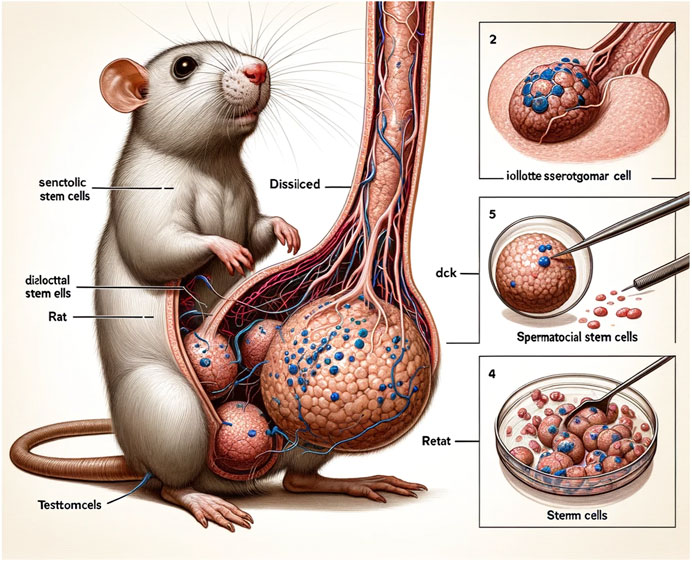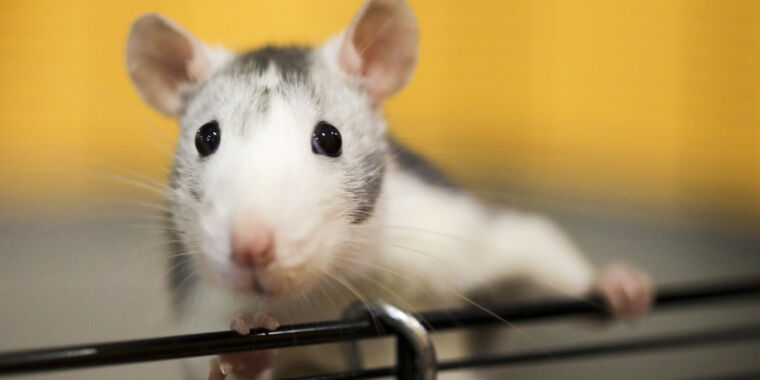Scientists aghast at bizarre AI rat with huge genitals in peer-reviewed article | It’s unclear how such egregiously bad images made it through peer-review.::It’s unclear how such egregiously bad images made it through peer-review.
The first image from the article:

dck 🤣
testtomcels. Test them cells, they’re too big
Not sure what’s bothering everyone, it’s clearly a very normal rat. It’s even helpfully labelled “Rat” in case you’re not sure.
Just a rat and its perfectly normal dck.
It’s not a rat. It’s clearly a grouping of “senctolic stem cells”
At that point it’s the dick that got a rat 😆
I saw this posted yesterday without context, I didn’t realize this came from an actual published paper. Yikes.
Reminds me of that old southpark episode where Randy gets ball-cancer
Buffalo soljah
“It’s unclear how such egregiously bad images made it through peer-review.”
That’s because the paper wasn’t peer-reviewed at all. In fact, the majority of published medical and psychological papers are never reviewed or replicated.
The scientific method has sold out to the profit incentive, at least in academia.
This article was supposedly reviewed. The reviewers are listed on the article’s web page. This publisher is normally reputable, so I’d tend to believe it, even though the image was obviously not properly scrutinized. The article was also retracted after 3 days. I’m not saying there are no problems with science publications, but the things you are saying are not true for this one case. Also this is a secondary source, so there is no original data here, just an article citing a lot of primary sources to summarize the topic. So, the replication issue doesn’t even apply to this paper. Again all valid issues in general, but not so much here…
Please read the Wikipedia article about the replication crisis that I’ve linked. This is a widespread problem. Even the most prestigious cancer research institute in the world, Dana-Farber, has admitted to egregious forgery and plagiarism of their formerly published research.
“Publish or perish” indeed…
I did read that article the first time you linked it. Can you go back and read my reply again? I agreed that there is a problem with reproducibility, but that has nothing to do with a paper where no experiments were done.
So it’s OK to publish “research” that’s been generated by AI so long as there are no experiments involved? I’m sorry. I don’t understand what you’re getting at.
There has clearly been a massive decline in academic integrity lately, as evidenced by this ridiculous paper and so many others. Why should any of it be excusable?
It’s like I’m taking to a wall. I completely agree with you that this article is egregious. I’m simply pointing out that your talking points were completely invalid when it comes to this, and bringing up reproducibility and non peer reviewed articles retracts from the point that this article followed those rules and was still published. Blame the reviewers, blame the editor, blame the fame hungry scientists, but bringing up totally unrelated problems with science pubs makes you sound like an idiot, which clearly you are. Go ahead and reply again l. I will not bother reading it.
The article was also retracted after 3 days.
Scientific articles should never be retracted. Publishers should make that impossible. Scientists should have balls and be able to stand by their word.
no it’s important to have a mechanism by which to say “this was wrong. we fucked up. don’t use this as a source, attempt to replicate it, or use its results as a basis for new research.” intellectual honesty and rigor are more important than “balls”.
I don’t see the problem with attempting to replicate it, so long as you are informed that (as far as we now know) the experiment will not go the way it was intended. But you might learn something new, or find out that in specific circumstances, it actually does work.
to have a mechanism by which to say "this was wrong. we fucked up.
Yes. But then you do not delete anything. You ADD this statement and leave the original stuff untouched, so that everybody can see afterwards what has been going on.
(Unless you want to become a politician)
funny, that’s exactly what a retraction is. you don’t destroy the original stuff, you just publish a statement that says “Hey, that stuff? it’s no good.” individual journals have their own policies, of course, but that’s the template from which reputable journals build their policies. so the problem you’re trying to fix simply doesn’t exist.
They had to have balls as big as that rat’s to publish it in the first place.
Retractions are important in case issues with the method are found after publication. For example, if it turns out a piece of equipment was improperly calibrated and so the results can’t be trusted, a retraction of any work based on those results would be expected.
Review and replication are completely different things. If publications had to replicate results during review nothing would get published and submission fees would be through the roof
At this point somebody should really create a /c/Aipocalypse community or something to collect stuff like this.
deleted by creator
The impact of image and text generators on scientific research is a blessing disguised as a curse, as it shows how sloppy (or in this case, non-existent) reviewing has become.
Perhaps it’s time to review the reviewing?
The article in question is titled “Cellular functions of spermatogonial stem cells in relation to JAK/STAT signaling pathway,” which was authored by three researchers in China, including the corresponding author Dingjun Hao of Xi’an Honghui Hospital. It was published online Tuesday in the journal Frontiers in Cell and Developmental Biology.
The issue of fake papers coming out of China has been known as an epidemic for at least a decade. “Publish or perish” is a worldwide problem but it’s another level there.
AI just makes this funnier.
About a decade back, a reputable scientist published an article in a top journal in his field, “proving” that people are able to see the future. People said the same thing then, but I doubt anything has changed.
This is the best summary I could come up with:
Appall and scorn ripped through scientists’ social media networks Thursday as several egregiously bad AI-generated figures circulated from a peer-reviewed article recently published in a reputable journal.
But, looking closer only reveals more flaws, including the labels “dissilced,” Stemm cells," “iollotte sserotgomar,” and “dck.”
Many researchers expressed surprise and dismay that such a blatantly bad AI-generated image could pass through the peer-review system and whatever internal processing is in place at the journal.
One scientific integrity expert questioned whether it provide an overly complicated explanation of “how to make a donut with colorful sprinkles.”
The image is supposed to provide visual representations of how the signaling pathway from Figure 2 regulates the biological properties of spermatogonial stem cells.
As such, research journals have recently set new authorship guidelines for AI-generated text to try to address the problem.
The original article contains 496 words, the summary contains 137 words. Saved 72%. I’m a bot and I’m open source!
The journal is: Frontiers in Cell and Developmental Biology
Non-rhetorical question: Is there any journal with “Frontiers” in the name that is not a bit lawless?
To me, it implies that the journal is more “open-minded”, for better or worse.
I don’t have the answer to your question, but have you looked at the article? I don’t think any journal would typically be publishing utter nonsense as the images in it
Not a reputable journal. Not one where science actually takes place. But there are journals for anything, including journals where the peer-review is limited to your payment.
ah yes, the wonders of predatory publishing







